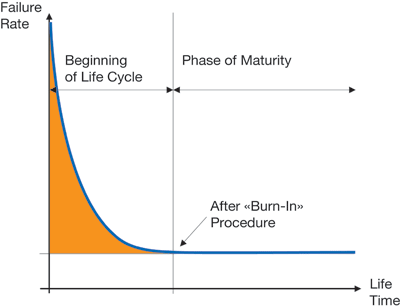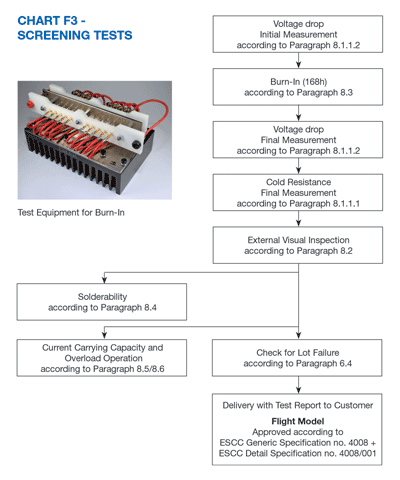Components used in space must have extremely high reliability
BY THOMAS HUBMANN
Schurter, Santa Rosa, CA
http://www.schurterinc.com
It is no longer possible to picture our every day life without electronics. The equipment and gadgets we have come to depend upon are all likely to include one of the earliest inventions – the fuse as an overcurrent protector. However, if fuses are to be used for applications in space, these components will be subjected to extremely stringent quality requirements, such as those according to the components qualification process with the European Space Agency ESA wherein complex and highly demanding quality assurance processes are set forth to ensure exceptionally high standards. The latest Schurter Proof of Performance called MGA-S, is for an SMD fuse to have a similar life expectancy, 20 to 30 years, as a satellite.

Fig. 1. Fuses used in space must meet extremely stringent quality specifications.
Fuses, in general serve as overcurrent protectors in electrical circuits. In the event of a fault, such as a short circuit — the function of a fuse is to ensure that a device apparatus or circuit is disconnected from the power supply in a reliable and controlled manner. They can be connected on the primary and/or the secondary side. Very often, standards such as IEC or UL require, for the acceptance of a device at a customer’s premises, that at least one fuse is connected on the primary side.
Various types of loads — resistive, capacitive, or inductive — place differing requirements on the fuse that need to be taken into consideration in the selection of the fuse. For instance, with capacitive loads where, for power supplies using a rectifier and capacitor, high inrush peaks are typical, the aspect of impulse loading must be observed and appropriate calculations made.
Quite naturally these general points are also valid for fuses used in the aerospace industry where correct dimensioning of the fuse for the application must be carried out. However, the difference between a fuse for aerospace and a standard fuse lies with the requirements on the component itself. Every single component is extensively tested by means of a burn-in procedure for its correct functioning and the results are recorded.
Aerospace requirements on components
Components that are used in aerospace must possess the following properties:
Hermetically tight and robust construction such that with a disconnection, no arcs or gasses can escape.Consistent minimum and maximum pre-arcing times with overcurrents, independent from the mode of operation (for example, in a vacuum). The red triangles in Fig. 2 depict additional and defined pre-arcing time points at certain over-current levels not given with a standard fuse.Definite disconnection of overcurrents at rated voltageStable derating curve of the components at higher ambient temperatures.High durability against mechanical vibration and shock.

Fig. 2. Time/current characteristic.
The thin film technology (metal sputter process) increases the long term stability of the fuse through the homogeneous crystal structure of the metal layers. This long-term stability is influenced by leakage loss, ageing and ambient temperature in combination with thermal cycles, which with satellites are quite regular.
The technology widely used today for standard fuses is not able to fulfil the requirements for long term reliability of 20 to 30 years. This is mainly due to the ageing phenomena of tinned fuse links.
Component fault rates
It is a fact that component fault rates are at their highest during the early part of the life cycle (See Fig. 3 ). After this phase has passed, these types of components have then a life of 20 to 30 years, which is also the operating life of a satellite.

Fig. 3. Component failure rates are highest early in the life cycle.
The object of the burn-in procedure is to bridge this initial phase and thus to eliminate these early fault occurrences. All components for aerospace are subjected to this burn-in procedure (See Fig. 4 ).
Burn-in and test procedures
Here are the sequences of the burn-in and test procedures for components used in space.
1. Following the final test after production, cold resistance and voltage drop are measured for each individual fuse.
2. The burn-in is a combination of a current and temperature test carried out for every fuse under the following conditions:
* Duration: minimum 168 hours.
* Current: 64% of rated current.
* Ambient temperature: 80C.
Continual monitoring of current and voltage during the entire test.
3. After burn-in, cold resistance and voltage drop are measured again for each fuse. The two sets of values may display a maximum of 10% deviation; otherwise the fuse has failed the test. Should there be 5% or more from a production series that lie outside this tolerance, the entire production lot is disposed of and a new series of fuses is produced.
4. Every fuse undergoes a strict visual check so as to exclude material faults.
5. Additional test fuses are manufactured with each production series that have also been subjected to burn-in and its tests.

Fig. 4. The sequence of the burn-in and test procedures.
Time-current characteristics and solderability tests are carried out to ascertain that these properties are still fulfilled. Dependent on customer requirements further qualification tests can be carried out.
As a result of this extensive procedure, an absolute minimum failure rate is achieved as well as a complete guarantee of the electrical properties. A detailed test report is made for each order and supplied with the fuses.
Component qualification
As a department of the ESA (European Space Agency), the ESCC (European Space Component Coordination) is responsible for the specification, qualification and procurement of components for aerospace. ESCC is also the highest authority for documentation, and qualifies new suppliers and components for aerospace applications. ESCC separates its qualification process into three main phases, each of which must be passed:
1. Manufacturer evaluation: audits are used to ascertain whether a manufacturer fulfils criteria requirements with regard to organization, internal processes and quality management.
2. Components evaluation: this begins with a design analysis by the ESCC. Following this, those manufacturing and test procedures are established that are to be recorded in the PID (Process Identification Documents) in accordance with the ESCC.
3. Qualification test phase: components are manufactured and tested exactly in accordance with the PID documents. Quality management monitors the processes and ensures traceability. Qualification is only awarded when all criteria requirements have been fulfilled.
There are two levels of specifications for fuses with the ESCC:
* ESCC Generic specification is valid for all fuses in general. Until 2006, no such specification existed: its fundamentals were created in close cooperation between ESCC and Schurter.* ESCC Detail specification covers those requirements that directly concern a particular component type.
The preparation of these specifications together with the entire qualification processes between ESCC and Schurter took two and a half years to complete.
Applications
Satellites are very often equipped with a multitude of electronic modules for a variety of functions, which are fed from a central supply unit. An example of this is the transmitting unit that is manufactured among other items by TESAT in Germany. This module amplifies the data signals that are transmitted via the antenna back to earth. The existence of numerous channels leads to a multiple redundant system. With an overcurrent caused by a fault in a channel, the fuse interrupts the supply in a secure and controlled manner. In a case such as this, the system switches over to another channel. The disconnected fuse thus ensures that no unnecessary current flows in the defective channel.
A parallel switching of two or more fuses is possible, should an application require a higher rated current than a single fuse can cover. As a result of current/temperature equalization between the fuses, simultaneous disconnection is ensured. It is to be noted that the fuses have the same values and that they do not influence each other with their operating temperature.
The demands of the aerospace industry for qualified products used in space are extremely high. The ESA, NASA and other worldwide agencies provide a well-founded qualification process, and customers expect to have professional and comprehensive support from manufacturers. With the MGA-S, Schurter is in not only possesses a sophisticated product that has been qualified by the ESCC, but they are also prepared to face this complex challenge of developing solutions. ■
Advertisement
Learn more about Schurter





